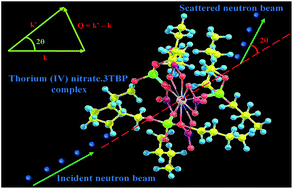Trends in small angle neutron scattering of actinide–trialkyl phosphate complexes: a molecular insight into third phase formation
Abstract
The “third phase” formation phenomenon in solvent extraction is due to the aggregation of extracted species and formation of reverse micelles. As Small Angle Neutron Scattering (SANS) is a powerful tool to probe colloidal particles, it is considered as an important technique to study the aggregation behaviour of actinide complexes in solvent extraction systems. The actinide specific trialkyl phosphate (TalP) based extractants, namely, tri-n-butyl phosphate (TBP), tri-iso-butyl phosphate (TiBP), tri-sec-butyl phosphate (TsBP) and tri-sec-amyl phosphate (TsAP) have been examined for the first time using the SANS technique to investigate third phase formation phenomena with some of the actinides. SANS was employed to get insight into third phase formation in the extraction of Th(IV) and U(VI) from 1 M HNO3 by 1.1 M solutions of TalP in deuterated dodecane (n-C12D26, 98 atom% D). Deuterated diluent was used in order to provide contrast during the neutron scattering measurements. Potential energy and the stickiness parameter of reverse micelles formed in the above solvent systems have been quantified as a function of organic metal loading. The data are fitted using Baxter's sticky-sphere model. The stickiness parameter, (τ−1) a measure of the attractive interaction between the micelles, as well as the attractive potential energy (U0) was quantified. A clear correlation has been established between the stickiness parameter and the tendency for third phase formation with TalP systems. As U(VI) does not form a third phase with these extractants at 1 M HNO3, comparative studies were carried out with U(VI)–TalP complexes. These studies established lower stickiness and attraction between the micelles with the U(VI) system. The correlation between SANS parameters and third phase formation tendency was extended to a temperature dependence study and these studies established higher third phase limits when the temperature was enhanced, corroborating well with our experimental results. Our studies also revealed the “prediction of third phase formation” before its occurrence for a range of actinide–extractant systems.


 Please wait while we load your content...
Please wait while we load your content...